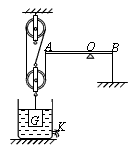问题
计算题
如图所示装置中,杠杆和滑轮的重力及滑轮的摩擦均可忽略不计,杠杆AB可以绕O点在竖直平面内自由转动,A端通过竖直方向的轻绳与滑轮组相连,在B端用一轻绳沿竖直方向将杠杆拉住,使其始终保持水平平衡。在滑轮组的下方,悬挂一圆柱形的物体,此物体被浸在圆柱形容器内的液体中。已知杠杆O点两侧的长度关系为AO=2OB,圆柱形物体的底面积为10cm2、高为12cm,圆柱形容器的底面积为50cm2。若容器中的液体为水,在水深为20cm时物体的上表面恰与水面相平,此时杠杆B端绳上的拉力为F1;打开圆柱形容器下方的阀门K,将水向外释放,直到物体露出水面的体积为其总体积的2/3时,将阀门K关闭,此时杠杆B端绳上的拉力为F2,且F1 :F2=3:5。若容器中液体为某种未知液体,其质量与最初容器中的水的质量相等,此时未知液体的深度为18 cm,杠杆B端绳上的拉力为F3。(取g=10N/kg) 求:
(1)圆柱形物体的密度;
(2)未知液体的密度;
(3)作用在B端的拉力F3大小;(小数点后保留两位)
(4)未知液体对圆柱形容器底部的压强。

答案
(1)2 g/cm3 ;
(2)1.1 g/cm3 ;
(3)为0.87N ;
(4)1980Pa
